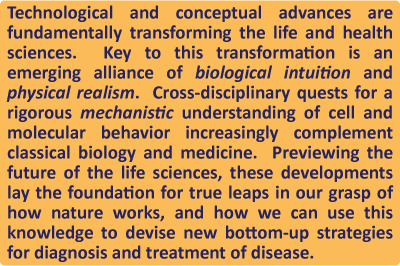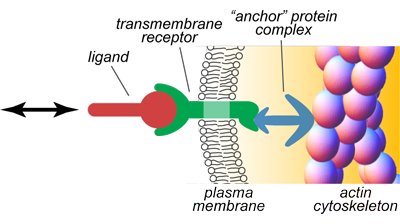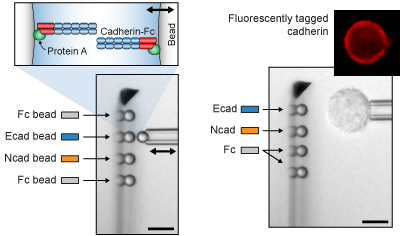Jump to: Current Projects
Our main interest is in understanding the inner workings of the small bits of life. Bridging the nano- (molecular) and micro- (cellular) scales, we study single biomolecule interactions within their physiologically relevant cellular context, and ask conversely how the cellular machinery orchestrates molecular interactions to carry out biological functions.
Common to our research strategy is an emphasis on mechanistic principles. These fundamental cause-effect relationships usually govern more than one process or disease. By providing new core insight into innate immunity, infectious disease, cancer metastasis, etc., our research thus lays the groundwork for innovative and potentially high-impact approaches to diagnosis and treatment of a range of medical conditions.
Biomolecular interactions take place at the crossroads of biology, chemistry, and physics. With few exceptions,  biomolecules are attached to subcellular structures like membranes or the cytoskeleton. Their biochemistry is modulated by the physical properties of these structures. Therefore, a comprehensive understanding of nano-to-microscale biological behavior must be based on an interdisciplinary perspective. Using pioneering biophysical and bioengineering approaches, and integrating experiment and theory, we study nature’s own “engineering design” by pursuing questions like:
biomolecules are attached to subcellular structures like membranes or the cytoskeleton. Their biochemistry is modulated by the physical properties of these structures. Therefore, a comprehensive understanding of nano-to-microscale biological behavior must be based on an interdisciplinary perspective. Using pioneering biophysical and bioengineering approaches, and integrating experiment and theory, we study nature’s own “engineering design” by pursuing questions like:
- → How does force affect the kinetics of stress-bearing biomolecular interactions?
- → How do membrane nanotubes form? What is their physiological relevance?
- → How easy is it to stretch a membrane? How do cells recruit surface area when needed? How much tension does it take to lyse a membrane?
- → How do white blood cells withstand high shear forces when binding to the inflamed endothelium, yet avoid clogging vessels in regions with low flow?
- → How do motile immune cells convert biochemical stimuli—such as receptor ligation—into mechanical forces? How do they coordinate different forces to achieve a particular cellular deformation?
- → Why, and how, do phagocytes balance cortical tension and cytoplasmic viscosity when “eating” pathogenic invaders?
Links to CURRENT PROJECTS
Phagocytosis
|
Nanomechanics of Biomolecular Interactions
|
Flow Cytometry |
Leukocyte Mechanics |


